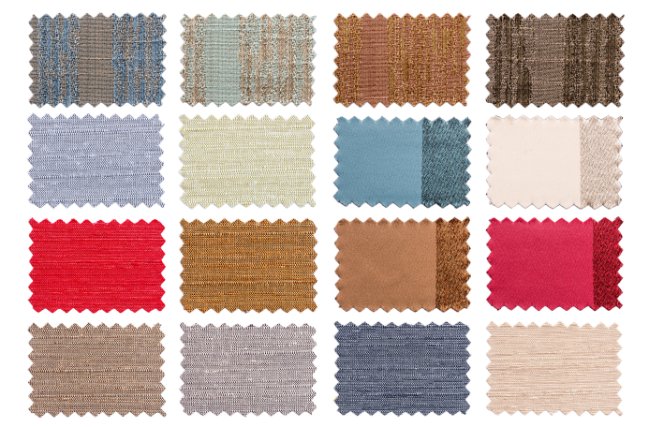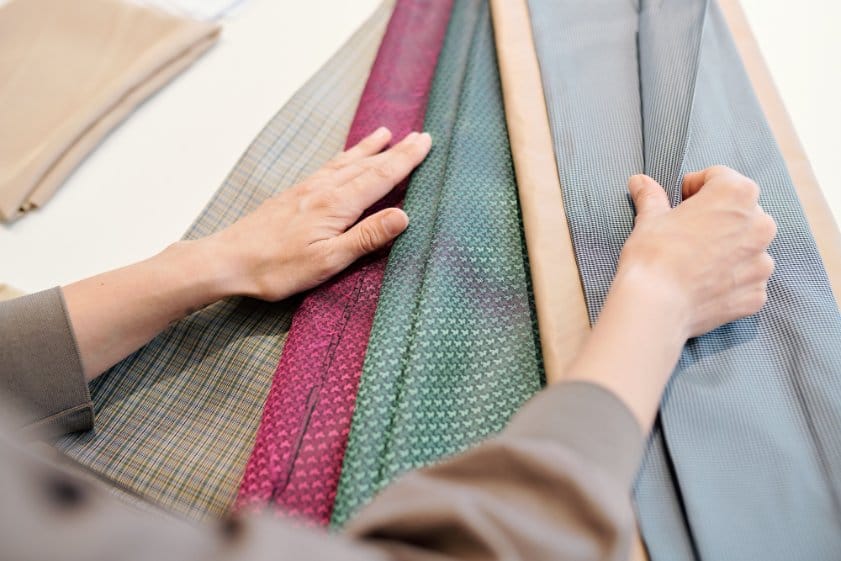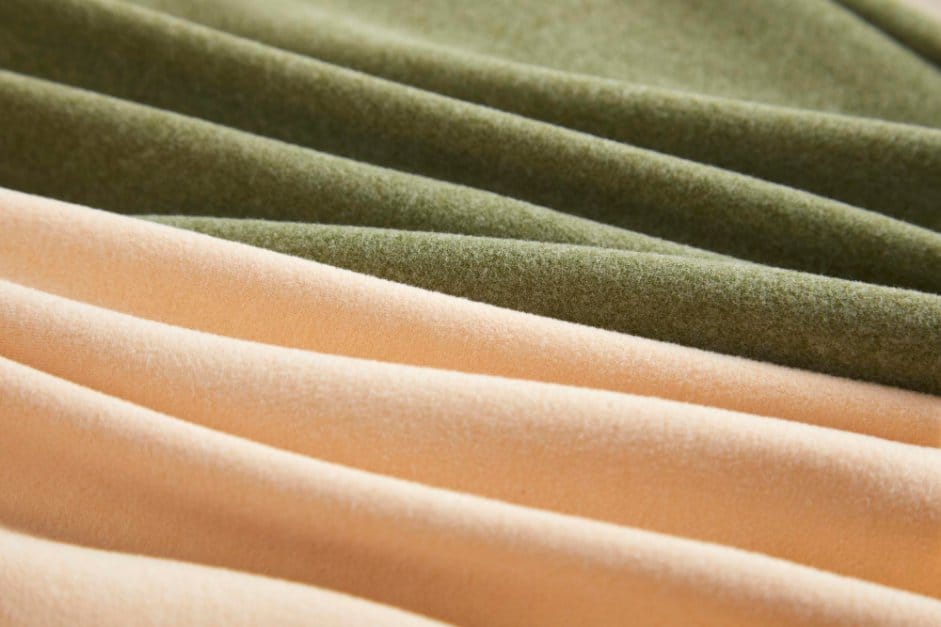Expert insights into sustainable materials, smart textiles, and the bold patterns reshaping fashion and interior design
The fabric industry is experiencing its most exciting transformation in decades. As designers and consumers shift toward sustainable materials while demanding luxury and performance, 2025 brings revolutionary changes to how we think about textiles. From eco-friendly innovations to cutting-edge smart fabrics, this year’s trends balance environmental responsibility with sophisticated style.
This comprehensive guide explores everything shaping fabric choices in 2025, helping you make informed decisions whether you’re designing fashion collections, decorating your home, or simply staying current with textile innovations.
Table of Contents
Key Takeaways
- Sustainable fabrics lead the market with 40% better environmental performance than traditional options
- Smart textiles and performance fabrics merge technology with comfort
- Bold patterns and maximalist designs replace minimalist trends
- Regional sourcing and ethical production become non-negotiable standards
- Interactive and personalized fabric experiences transform shopping
The Sustainability Revolution: Leading 2025 Fabric Trends
Sustainability drives the biggest changes in fabric selection this year. Consumers increasingly choose materials that minimize environmental impact without sacrificing quality or style. This shift represents more than a trend – it’s becoming the new standard for responsible textile production.
Organic Cotton Innovations
Modern organic cotton production uses 40% less water than traditional cultivation methods. New farming techniques focus on soil health and biodiversity while maintaining the natural durability people love about cotton. Manufacturers now blend organic cotton with recycled materials, creating stronger fabrics that last longer and perform better.
Advanced non-toxic dyes enhance organic cotton’s performance while preserving its natural properties. These innovations make organic cotton suitable for both everyday wear and luxury applications, from comfortable toddler clothing to high-end fashion pieces.
According to Textile Exchange’s 2024 Global Textile Industry Report, organic cotton production has increased by 35% year-over-year, with major brands committing to 100% sustainable fiber sourcing by 2030. This shift reflects growing consumer demand for transparency in textile supply chains.
Recycled Polyester Advancements
The recycled polyester market has transformed dramatically. Each pound of recycled polyester diverts approximately 12 plastic bottles from landfills. New processing methods eliminate the synthetic feel many people associate with recycled materials, creating fabrics that feel soft and natural against skin.
These advanced recycled fabrics match virgin polyester in strength and color retention. Understanding how to care for polyester helps maintain quality through hundreds of wash cycles without degradation.
Emerging Sustainable Materials
Several innovative materials are gaining significant traction:
Tencel and Cork Fabric: Tencel production uses 95% less water than cotton processing. Cork fabric provides a leather-like alternative that’s naturally water-resistant and durable. Cork oak trees regenerate after harvesting, making this a truly renewable resource.
Plant-Based Alternatives: Pineapple leather and mushroom textiles offer unique textures while maintaining eco-friendly credentials. These materials give designers new options for creating distinctive pieces without environmental compromise.
Smart Sustainability Tracking: QR codes embedded in fabrics allow consumers to track their garment’s environmental impact. This transparency helps shoppers make informed decisions about their purchases.
Revival of Classic Textures with Modern Performance
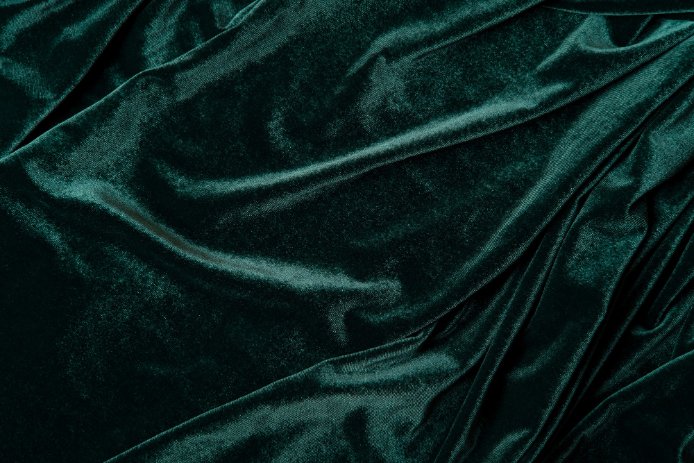
Traditional fabrics are experiencing a renaissance, enhanced with modern manufacturing techniques that improve durability and functionality while preserving their classic appeal.
Velvet’s Grand Comeback
Velvet returns as a major trend with improved practical features. Modern velvet includes stain resistance and enhanced durability, making it suitable for everyday use rather than just special occasions. Rich jewel tones and unexpected pastels expand velvet’s versatility beyond traditional applications.
Professional designers recommend velvet blends with synthetic fibers for high-traffic areas. These combinations maintain velvet’s luxurious appearance while providing better wear resistance.
Bouclé Updates
The cozy texture of bouclé now comes in fresh colors beyond traditional neutrals. New manufacturing techniques make bouclé easier to clean and more durable. This fabric works beautifully in accent pieces like throw pillows or statement chairs, especially when paired with smooth fabrics for contrast.
Enhanced Chiffon
Chiffon receives structural improvements while maintaining its signature floating quality. New weaving methods create more stable fabric that’s easier to work with. Popular applications include flowing dresses, light window treatments, and decorative accessories.
Bold Prints and Maximalist Movement

After years of minimalist design, bold patterns dominate 2025 fabric choices. This shift toward maximalism brings energy and personality to both fashion and interior design.
Statement Prints Take Center Stage
Oversized florals, geometric patterns, and contrasting colors demand attention. The key to wearing maximalist prints successfully involves mixing patterns with confidence. Try pairing large-scale geometrics with smaller accent prints or combining different patterns in complementary colors.
70s-inspired print mixing adds fresh energy to this trend. Designers encourage combining two or three different patterns to create dynamic, engaging looks.
Oversized Florals Transform Spaces
Giant botanical prints move beyond traditional floral patterns into modern statement pieces. These dramatic designs feature enormous roses spanning entire garments, tropical leaves in vibrant colors, and bold flower motifs with high contrast.
Large-scale prints work best on flowing fabrics that showcase the full design. Choose solid-colored accessories to let oversized floral pieces serve as focal points.
Explore Color Trends Visually: Want to see how these bold patterns evolved? Our Fabric Trend Timeline shows the complete journey from minimalism to maximalism, helping you understand where trends are heading next.
Fabric Technology and Performance Innovation
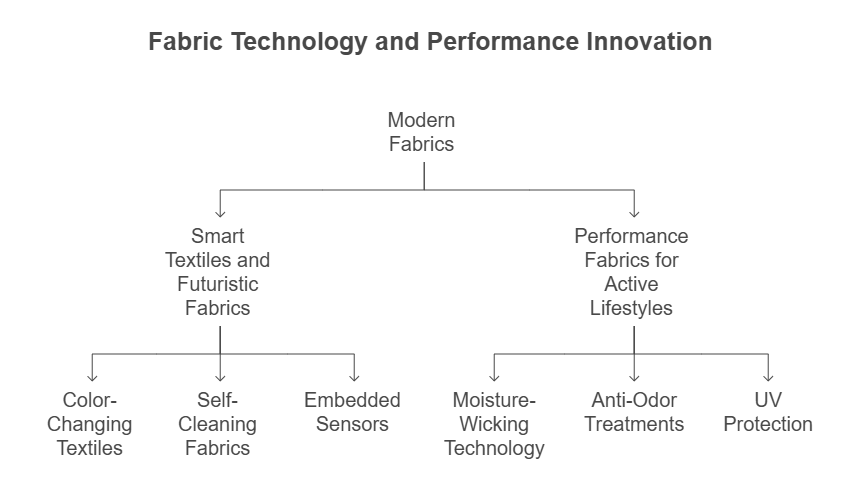
Modern fabrics integrate advanced technology to meet specific performance needs while maintaining aesthetic appeal.
Smart Textiles and Futuristic Fabrics
The future of fabrics includes remarkable innovations:
Color-Changing Textiles: Smart fabrics that change color with temperature variations adapt to body heat and environmental conditions. These materials represent the cutting edge of textile technology.
Self-Cleaning Fabrics: Nanotechnology creates fabrics that resist stains and odors naturally. These materials require less washing and maintain freshness longer, contributing to both convenience and sustainability.
Embedded Sensors: Some fabrics now include sensors that monitor health metrics, improve athletic performance, or charge electronic devices. These innovations blur the line between clothing and technology.
Performance Fabrics for Active Lifestyles
Athletic and outdoor fabrics use moisture-wicking technology to keep skin dry during workouts. Anti-odor treatments built into fabric fibers prevent odor buildup during intense activities. UV protection becomes standard in many outdoor-focused fabrics, providing skin protection during sun exposure.
Quick-drying properties make these fabrics ideal for swimming, running, cycling, yoga, and travel clothing. Understanding water-resistant fabric technology helps choose appropriate materials for specific activities.
Quality and Quantity Considerations
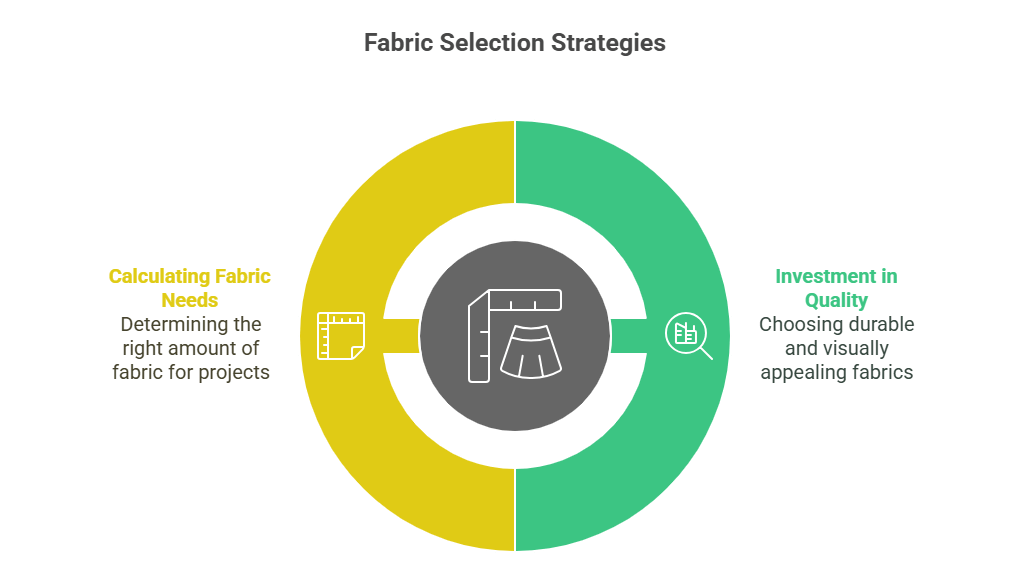
Smart fabric selection balances quality standards with appropriate quantities for projects.
Investment in Quality
High-quality fabrics justify their cost through better durability and appearance over time. Check for even weaving and color consistency before purchasing. Test fabric strength with gentle tugging to ensure materials maintain their shape without stretching or warping.
Fabric weight, measured in GSM (grams per square meter), indicates quality levels. Higher GSM numbers typically indicate more durable fabrics suitable for heavy use.
Calculating Fabric Needs
Start with pattern requirements and add 15-20% extra for pattern matching and corrections. Consider pattern repeat size, fabric width, seam allowances, and potential shrinkage when calculating needs.
For garments, measure twice before cutting. Body measurements plus wearing ease determine exact requirements. Heavyweight fabrics need extra material for proper draping and structural support.
Simplify Your Fabric Selection: Take the guesswork out of choosing materials with our interactive Fabric Selector Tool. Answer a few simple questions about your project and get personalized fabric recommendations that match both your needs and 2025 trends.
Fabric Applications in Interior Design
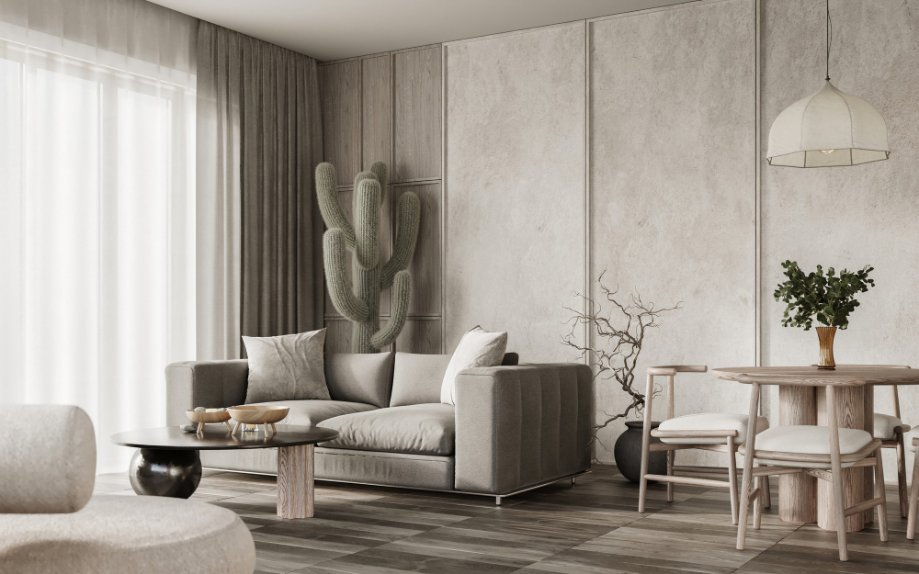
Textiles play crucial roles in creating cohesive, functional living spaces that reflect personal style and meet practical needs.
Modern Interior Integration
Maximalist fabric layering adds depth and personality to rooms. Mix bold patterns with subtle textures to create visual interest without overwhelming spaces. Velvet accent chairs paired with linen sofas provide sophisticated contrast.
Dynamic textiles work best when coordinated with wall colors and floor coverings. Select fabrics that complement existing decor while adding new dimensions to spaces.
Textile Influence on Room Atmosphere
Fabric selections directly impact room ambiance. Soft, plush materials create warmth and comfort in bedrooms and living areas. Heavy drapes control light and sound, making them perfect for entertainment spaces. Light, sheer curtains brighten rooms and add airy feelings.
Sustainable materials like organic cotton and recycled polyester help build eco-friendly interiors while maintaining style. Performance fabrics resist stains and wear in high-traffic areas while preserving aesthetic appeal.
Design Your Perfect Color Scheme: Creating cohesive interior spaces starts with the right color palette. Our 2025 Fabric Color Palette Generator matches trending colors with specific fabric types, making it easy to coordinate your entire design project.
Interactive Fabric Selection Guide
Step 1: Define Your Project
- Fashion design
- Home decoration
- Performance wear
- Children’s clothing
Step 2: Choose Your Priority
- Sustainability
- Durability
- Luxury feel
- Technical performance
Step 3: Select Fabric Category
- Natural fibers (cotton, linen, silk)
- Synthetic materials (polyester, nylon)
- Innovative blends
- Smart textiles
Step 4: Consider Care Requirements Understanding how to care for different fabrics ensures longevity and performance.
Try Our Interactive Tools: Ready to put this knowledge into action? Our Fabric Selector Tool helps you find the perfect fabric based on your specific project needs, while our 2025 Color Palette Generator creates trend-aligned color schemes with matching fabric recommendations.
Global Fabric Market Insights

Most Valuable and Rare Fabrics
The most valuable fabric in the world remains vicuña wool, commanding prices up to $3,000 per yard due to its extreme rarity and exceptional softness. Other luxury options include:
- Mulberry silk: The highest grade silk with unmatched luster
- Cashmere: Especially from Kashmir goats, prized for softness
- Sea silk: Made from byssus fibers, extremely rare and historical
Fabric Production Leaders
China dominates global fabric production, manufacturing approximately 50% of the world’s textiles. Other major producers include:
- India: Specializing in cotton and traditional textiles
- Turkey: Known for high-quality cotton and home textiles
- Italy: Leading luxury fabric production
- Bangladesh: Major garment manufacturing hub
Most Widely Used Fabrics
Cotton remains the most widely used natural fiber globally, while polyester dominates synthetic fabric production. In fast fashion, polyester blends account for over 60% of garments due to their low cost and versatility.
Future of the Textile Industry
What Fashion Will Look Like in 2050
By 2050, the clothing industry will likely feature:
- Fully circular production: Zero-waste manufacturing with complete recyclability
- Bio-fabricated materials: Lab-grown fabrics from algae, bacteria, and fungi
- Personalized fit technology: 3D body scanning for perfect sizing
- Climate-responsive clothing: Fabrics that adapt to weather conditions automatically
Textile Sector Innovations
Current innovations shaping the future include:
- Molecular recycling: Breaking down fabrics to molecular level for perfect recycling
- Digital fabric printing: Reducing water usage by 90% compared to traditional dyeing
- Blockchain tracking: Complete supply chain transparency from fiber to finished product
- AI-designed patterns: Machine learning creating optimized fabric structures
McKinsey & Company’s latest fashion industry analysis projects that sustainable materials will capture 25% of the global textile market by 2030, driven by both regulatory requirements and consumer preferences. The consulting firm identifies smart textiles and bio-fabricated materials as the fastest-growing segments, with potential market values exceeding $50 billion globally.
Decorative Techniques and Finishing
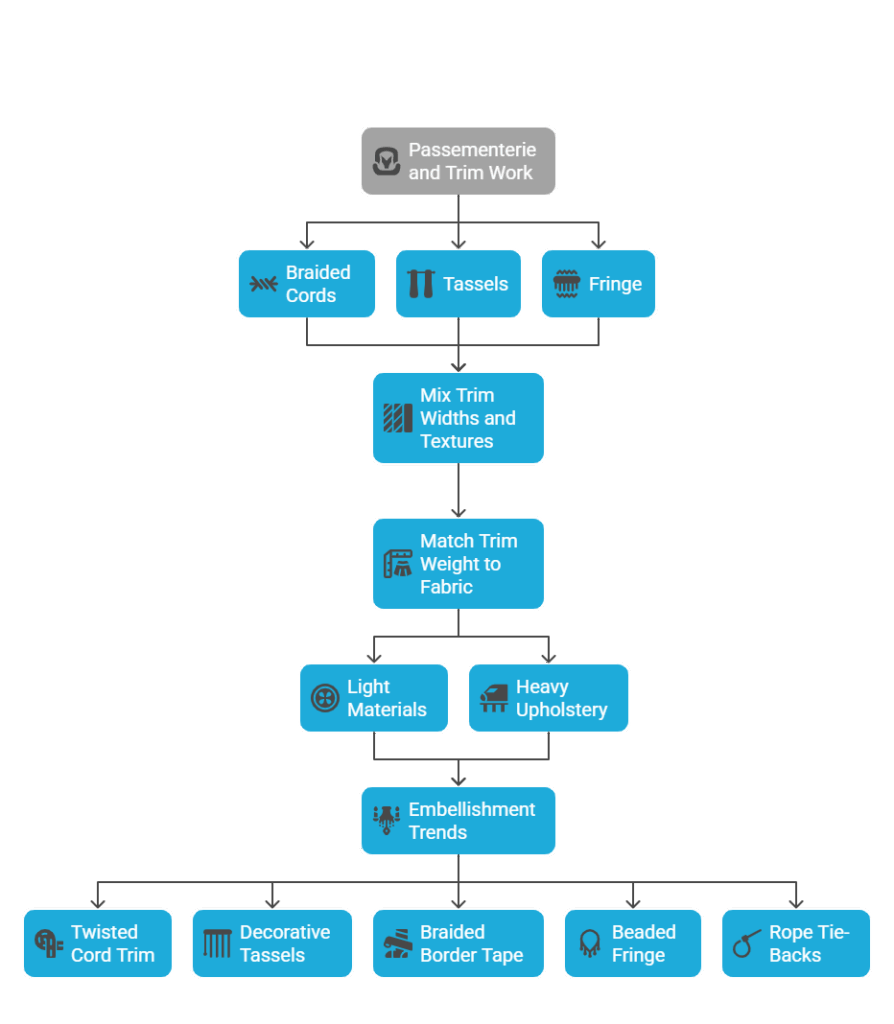
Passementerie and Trim Work
Decorative trims and tassels add sophistication to upholstery and window treatments. Braided cords, tassels, and fringe outline cushions or accent drapery panels. Classic bullion fringe works beautifully along furniture edges, while metallic cord trim or glass beaded tassels provide modern updates.
Mix different trim widths and textures on single pieces for rich visual interest. Match trim weight to fabric – light materials need delicate trims, while heavy upholstery supports substantial passementerie.
Embellishment Trends
Popular decorative options include:
- Twisted cord trim for elegant edging
- Decorative tassels for window treatments
- Braided border tape for furniture
- Beaded fringe for dramatic effect
- Rope tie-backs for curtains
Regional Fabric Trends and Sourcing
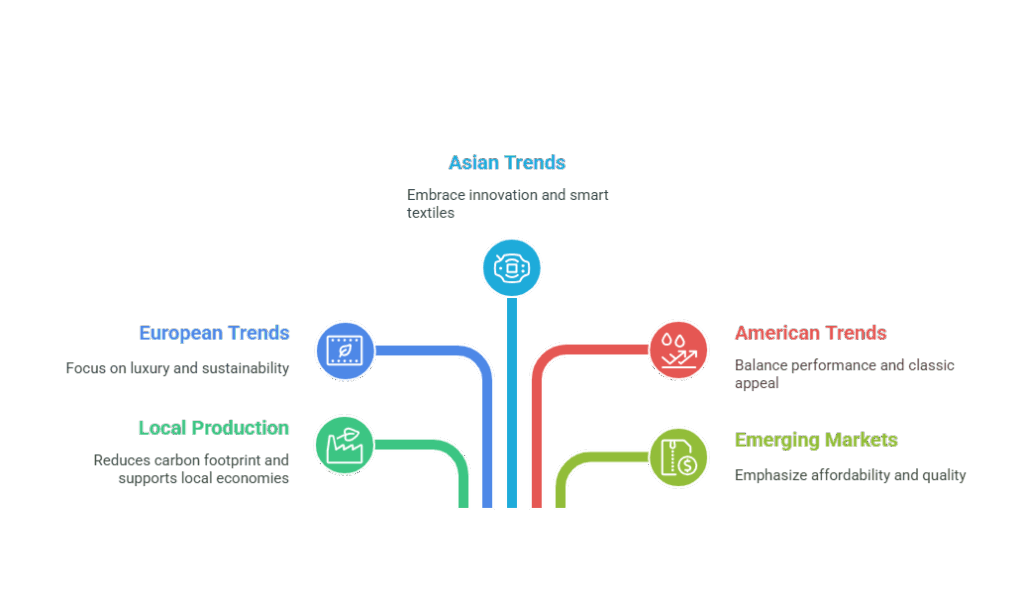
Local Production Movement
Regional sourcing reduces carbon footprints while supporting local economies. Many brands now prioritize nearby suppliers to ensure quality control and ethical production standards. This shift creates opportunities for regional textile specialties to gain recognition.
Global Trend Variations
Fabric preferences vary significantly by region:
- European markets: Focus on luxury natural fibers and sustainable production
- Asian markets: Embrace innovative technology and smart textiles
- American markets: Balance performance features with classic appeal
- Emerging markets: Emphasize affordability while improving quality standards
Seasonal Fabric Considerations
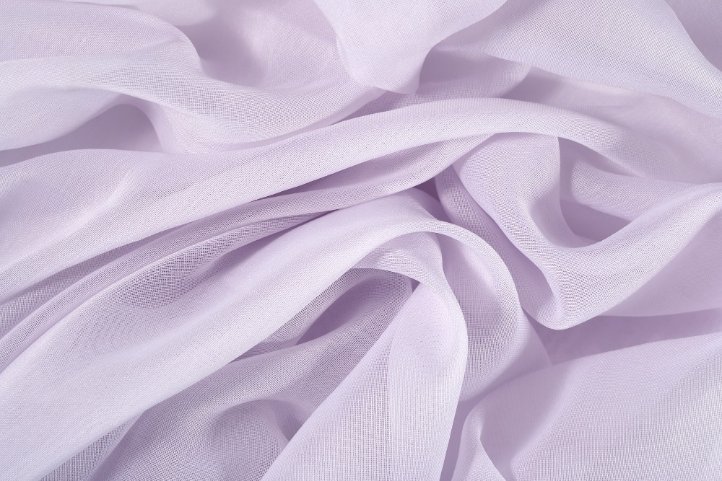
Spring/Summer 2025 Highlights
Lightweight fabrics dominate warm-weather collections:
- Sheer fabrics: Organza, chiffon, and tulle for layering
- Breathable cottons: Enhanced with moisture-wicking properties
- Technical linens: Blended with synthetic fibers for improved performance
- UV-protective fabrics: Built-in sun protection for outdoor activities
Fall/Winter 2025 Projections
Winter fabrics will emphasize:
- Insulating materials: Advanced synthetic insulation
- Luxury textures: Enhanced velvet and bouclé
- Smart heating elements: Fabrics with integrated warming technology
- Sustainable wools: Ethically sourced and processed
Fabric Care and Maintenance Guide
| Fabric Type | Washing Temperature | Drying Method | Special Care |
|---|---|---|---|
| Organic Cotton | 30-40°C | Air dry preferred | Avoid bleach |
| Recycled Polyester | Cold water | Low heat tumble | Anti-static sheets |
| Tencel | Cold water | Air dry | Gentle cycle only |
| Velvet | Dry clean | Professional only | Steam to refresh |
| Smart Textiles | Follow manufacturer | Specific instructions | Avoid fabric softener |
Understanding proper care extends fabric life significantly. Cotton care and synthetic fabric maintenance require different approaches for optimal results.
Frequently Asked Questions
What fabric sells the most globally?
Cotton remains the top-selling natural fiber, while polyester dominates synthetic fabric sales. Combined, these two materials account for over 70% of global textile production.
What is the most sustainable fabric to produce?
Hemp ranks as the most sustainable fabric due to its minimal water requirements, soil improvement properties, and complete plant utilization. Tencel follows closely with its efficient production process and biodegradability.
Which fabric is currently in highest demand?
Performance fabrics with moisture-wicking and odor-resistance properties show the strongest growth. Sustainable alternatives to traditional materials also experience increasing demand across all market segments.
What clothing item sells the most worldwide?
T-shirts and basic tops represent the highest-volume clothing sales globally, followed by underwear and socks. These essential items drive consistent demand across all demographics.
What are the three most common fabrics used today?
Cotton, polyester, and cotton-polyester blends comprise the majority of fabric usage worldwide. These materials offer versatility, affordability, and wide availability across global markets.
How will technology change fabrics by 2030?
Smart textiles with embedded sensors, self-cleaning properties, and climate adaptation will become mainstream. Bio-fabricated materials from renewable sources will supplement traditional fiber production significantly.
What innovations are transforming the textile industry?
Key innovations include molecular recycling, digital printing, blockchain tracking, AI-designed patterns, and bio-fabricated materials. These technologies address sustainability, efficiency, and customization demands.
Which regions produce the highest quality fabrics?
Italy leads luxury fabric production, Japan excels in technical textiles, India specializes in traditional natural fibers, and Switzerland produces the finest specialty fabrics. Each region brings unique expertise to global markets.
Conclusion
The fabric landscape of 2025 represents a perfect convergence of sustainability, technology, and style. As environmental consciousness drives innovation, manufacturers create materials that don’t compromise on quality or performance. From organic cotton using 40% less water to smart textiles that adapt to body temperature, this year’s trends satisfy both practical needs and aesthetic desires.
The shift from minimalist to maximalist design opens new creative possibilities. Bold prints, oversized florals, and textured materials allow personal expression while meeting functional requirements. Whether choosing fabrics for fashion design, home decoration, or technical applications, 2025 offers unprecedented options.
Key Recommendations for 2025:
- For Designers: Embrace sustainable materials early to meet growing consumer demand. Experiment with smart textiles for competitive advantages. Consider regional sourcing to reduce environmental impact and support local communities.
- For Consumers: Invest in high-quality fabrics that last longer and perform better. Learn proper care techniques to extend fabric life. Support brands that prioritize sustainability and ethical production.
- For Industry Professionals: Stay informed about emerging technologies like bio-fabrication and molecular recycling. Develop expertise in performance fabrics as this market segment continues growing rapidly.
The fabric choices made in 2025 will influence fashion and interior design for years to come. By understanding current trends, emerging technologies, and sustainability requirements, everyone can make informed decisions that support both personal needs and environmental responsibility. The future of textiles looks bright, sustainable, and incredibly innovative.
Get Started with Interactive Tools
Ready to apply these 2025 fabric trends to your projects? We’ve created three specialized tools to help you make informed decisions:
- Fabric Selector Tool: Get personalized fabric recommendations based on your project type, sustainability preferences, and style goals
- Fabric Trend Timeline: Explore the evolution of textile trends from 2020-2030 and understand where the industry is heading
- Color Palette Generator: Create 2025-trend-aligned color schemes with matching fabric suggestions for any design project
These tools combine the insights from this guide with interactive features that make fabric selection simple and trend-focused.
As the industry continues evolving, staying current with fabric trends, understanding new materials, and embracing sustainable practices will remain essential for success. The intersection of technology, sustainability, and style creates endless possibilities for creative expression and functional excellence.

